
I set a goal to read 20 non-content books in 2016. That might sound like a weirdly basic goal, but with Content Science growing I was struggling to find time for this enjoyable mind-expanding activity. Turns out I exceeded my goal; I read or listened to 24 books this year that were not directly related to content. (It’s been a long time since I’ve overachieved. Tracy V. Wilson would be proud.) And, perhaps because I’m a bit obsessed with content, I found many lessons for content in these books.
So, as you plan your reading list, I wanted to share 11 of the books I found particularly interesting or useful. This list numbers the books so it’s clear I’m not cheating you … yes, there really are 11 books. But, no, these publications are not listed in order of my favorite. (That’s like picking which dog is your favorite. Impossible.) All of these books are available in digital and audio formats.
1. Right Away & All at Once
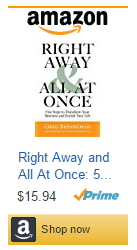 Stop doing what doesn’t work and do more of what does. Now, immediately, completely. What is the “what?” Greg Brenneman starts talking about business activities, drawing on his success as a “turnaround” CEO for Burger King, The Home Depot, and Continental Airlines as well as his success in private equity. Stop doing things that don’t make money, for example. But he ends talking about many personal applications. And, if you’re one of the many organizations facing a proliferation of content locked in pages, social channels, PDFs, or other outdated and ineffective approaches, it’s not hard to see the application here. Change your approach. Now. Don’t overthink it. Geez, I love this book.
Stop doing what doesn’t work and do more of what does. Now, immediately, completely. What is the “what?” Greg Brenneman starts talking about business activities, drawing on his success as a “turnaround” CEO for Burger King, The Home Depot, and Continental Airlines as well as his success in private equity. Stop doing things that don’t make money, for example. But he ends talking about many personal applications. And, if you’re one of the many organizations facing a proliferation of content locked in pages, social channels, PDFs, or other outdated and ineffective approaches, it’s not hard to see the application here. Change your approach. Now. Don’t overthink it. Geez, I love this book.
I’ll point out one more nuance I love, especially now as we face intense changes in content technology, automation, and data that will leave content dabblers even more behind. Brenneman embraces “all at once” change. Not coddling. Not churning on multi-phase change management initiatives and communication. Change everything needed to the point you start seeing results, and the rest will largely take care of itself. That might sound drastic, but when your organization needs to turn itself around (I’m thinking of you, companies and organizations who create and publish content like it’s 1999), it’s the only approach that works.
2. Seeing What Others Don’t: The Remarkable Ways We Gain Insights
 This book explores the science of intuition and insights, going beyond books such as “How We Decide” and weaving together a wide variety of examples and compelling research. Gary Klein offers useful categories of insights and methods of developing them. But, he also acknowledges a certain “magic” factor when the right person exposed to the right data, information, or observation delivers a remarkable insight. Klein’s categories are informing our approach to content intelligence, which ultimately must spur actionable insight. And, this book confirms what I said in Clout almost exactly 7 years ago. Data will never replace human judgment about content. Data are our eyes, helping us to see our situation clearly or differently. Data are not our brains and can’t decide for us.
This book explores the science of intuition and insights, going beyond books such as “How We Decide” and weaving together a wide variety of examples and compelling research. Gary Klein offers useful categories of insights and methods of developing them. But, he also acknowledges a certain “magic” factor when the right person exposed to the right data, information, or observation delivers a remarkable insight. Klein’s categories are informing our approach to content intelligence, which ultimately must spur actionable insight. And, this book confirms what I said in Clout almost exactly 7 years ago. Data will never replace human judgment about content. Data are our eyes, helping us to see our situation clearly or differently. Data are not our brains and can’t decide for us.
Reading this book also triggered an insight for me. I see what others don’t in content. While I can help many people see what I see—the potential, the opportunity, the value to every aspect of digital business—some people will never see it. If you’re like me and sometimes feel like you’re trapped in a weird version of “Sixth Sense,” where instead of seeing dead people you see content possibilities, take heart. Your expertise gives you a unique, valuable perspective that at times is beyond what other people can grasp.
3. Quiet
American society rewards extroversion. That you might already know. What you probably don’t already know is that this irrational preference for extroversion comes at a deep cost—the contributions and leadership of introverts in school, business, religion, and more. It partly drives the current epidemic of hiring narcissistic CEOs. Susan Cain guides you through the misconceptions about both extroversion and introversion, drawing on extensive research and real-world examples. She also offers practical ways and inspirational examples of introverts overcoming bias and challenges to achieve tremendous success. Whether you are an extrovert, introvert, or somewhere in between, you owe it to yourself, to your peers, and to the teams you lead to read this book.
4. Peak
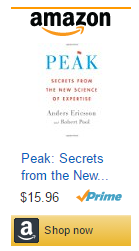 That whole 10,000-hours-to-master-a-skill thing that Malcolm Gladwell popularized is NOT correct. This book, written by the guy who conducted the research Gladwell referenced, explains why and much, much, more. The great news, explains Anders Ericsson, is anyone at any age can improve performance in a wide variety of areas because our brains are extremely adaptable. Much more so than you would guess. The key is deliberate practice. What is deliberate practice? The book explains the key characteristics that boil down to working both harder and smarter. This kind of practice literally changes your brain. The details matter, and it’s worth reading the book to understand those details and how you might apply them.
That whole 10,000-hours-to-master-a-skill thing that Malcolm Gladwell popularized is NOT correct. This book, written by the guy who conducted the research Gladwell referenced, explains why and much, much, more. The great news, explains Anders Ericsson, is anyone at any age can improve performance in a wide variety of areas because our brains are extremely adaptable. Much more so than you would guess. The key is deliberate practice. What is deliberate practice? The book explains the key characteristics that boil down to working both harder and smarter. This kind of practice literally changes your brain. The details matter, and it’s worth reading the book to understand those details and how you might apply them.
When It comes to content, we face a host of new challenges and opportunities that demand new skills. This book will reassure you that acquiring those new skills is achievable with hard work guided by the right coaching. Practicing the wrong thing is worse than no practice at all.
5. Smart Tribes
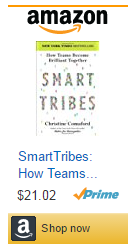 How do you make an organization efficient, effective, and smart—even if you’re growing and changing at breakneck speed? Christine Comaford draws on neuroscience and diverse experience with midsize and large organizations to offer highly practical guidelines and tools. The premise is that when members of your organization are afraid or feel threatened, they operate in a “critter state,” or primitive animal state. People in a “critter” state make stupid decisions and engage in dysfunctional behaviors, such as creating simple problems that they can solve to distract from challenges with solving bigger, more difficult problems. If you’re a leader who wants people in your organization to tackle and solve difficult problems and much more, you can do a lot to activate a “smart” state through your actions and words.
How do you make an organization efficient, effective, and smart—even if you’re growing and changing at breakneck speed? Christine Comaford draws on neuroscience and diverse experience with midsize and large organizations to offer highly practical guidelines and tools. The premise is that when members of your organization are afraid or feel threatened, they operate in a “critter state,” or primitive animal state. People in a “critter” state make stupid decisions and engage in dysfunctional behaviors, such as creating simple problems that they can solve to distract from challenges with solving bigger, more difficult problems. If you’re a leader who wants people in your organization to tackle and solve difficult problems and much more, you can do a lot to activate a “smart” state through your actions and words.
Any organization with a growing content team would benefit from this book. You will face no shortage of challenges and problems as we advance delivering the right content for the right people at the right time.
6. Playing to Win: How Strategy Really Works
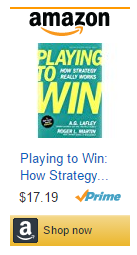 If you love strategy, then this book will be your new porn. I’m sure that comment would offend authors A.G. Lafley and Roger L. Martin, but it’s true. This duo articulates how they made strategy core to Procter & Gamble (P&G) and, consequently, quadrupling its revenue in 10 years. Now, you might wonder, “Hasn’t strategy always been fundamental to business?” No. This book sheds light on the history of strategy—or lack thereof—for business in general and for P&G in particular. Lafley and Martin generously share examples for a range of industries, markets, and products. Among my favorite examples is the turnaround they engineered for Oil of Olay, which is now Olay. Lafley and Martin took Oil of Olay from your grandmother’s face cream to a market-category-busting collection of skin care products.
If you love strategy, then this book will be your new porn. I’m sure that comment would offend authors A.G. Lafley and Roger L. Martin, but it’s true. This duo articulates how they made strategy core to Procter & Gamble (P&G) and, consequently, quadrupling its revenue in 10 years. Now, you might wonder, “Hasn’t strategy always been fundamental to business?” No. This book sheds light on the history of strategy—or lack thereof—for business in general and for P&G in particular. Lafley and Martin generously share examples for a range of industries, markets, and products. Among my favorite examples is the turnaround they engineered for Oil of Olay, which is now Olay. Lafley and Martin took Oil of Olay from your grandmother’s face cream to a market-category-busting collection of skin care products.
More specifically, I love their focus on winning and the implications for their focused analysis, innovative vision, and sound judgment. In deciding whether and how to turn Oil of Olay into Olay, for example, research led by Lafley and Martin discovered opportunity for a new category of skin care products between drug store (mass) and department store (prestige). And they not only discovered this opportunity, they were able to create quality products and market those products effectively to dominate the category—which they dub “masstige”—completely. Content products merit this same focus on winning, not just playing the game.
7. What Got You Here Won’t Get You There
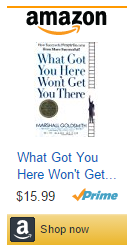 What made you successful isn’t necessarily what will keep you successful, espouses longtime researcher and organizational psychology consultant Marshall Goldsmith. The hilarious and true list of 20 annoying, counterproductive habits of successful people alone is worth this book. (Yes, you will probably see yourself in some of those habits, as I did.) Goldsmith explains how successful people, understandably, experience a kind of delusion that their success justifies their approach—even the annoying behaviors that hold them back—and makes them resistant to change. Thankfully, he also shares a proven approach to changing those habits, illustrated with examples of successful people who changed their behaviors and went on to enjoy even more success.
What made you successful isn’t necessarily what will keep you successful, espouses longtime researcher and organizational psychology consultant Marshall Goldsmith. The hilarious and true list of 20 annoying, counterproductive habits of successful people alone is worth this book. (Yes, you will probably see yourself in some of those habits, as I did.) Goldsmith explains how successful people, understandably, experience a kind of delusion that their success justifies their approach—even the annoying behaviors that hold them back—and makes them resistant to change. Thankfully, he also shares a proven approach to changing those habits, illustrated with examples of successful people who changed their behaviors and went on to enjoy even more success.
If you have enjoyed success with or because of content, don’t fall into what I call the success trap. Your work isn’t done, it’s only beginning. And don’t act like an asshat.
8. Being a Dog: Following the Dog Into a World of Smell
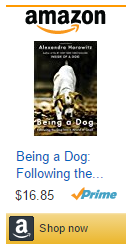 Scientist and dog lover Alexandra Horowitz sheds light on what your dog’s nose knows. (Hint: A lot.) Horowitz points out surprising gaps in our understanding of how a dog smells and its impact on their perspective and behavior. She shares entertaining glimpses into her research to help fill those gaps. And, perhaps most fascinating, she takes us on her journey to explore and develop her own sense of smell and, in the process, gain a unique empathy for the dog.
Scientist and dog lover Alexandra Horowitz sheds light on what your dog’s nose knows. (Hint: A lot.) Horowitz points out surprising gaps in our understanding of how a dog smells and its impact on their perspective and behavior. She shares entertaining glimpses into her research to help fill those gaps. And, perhaps most fascinating, she takes us on her journey to explore and develop her own sense of smell and, in the process, gain a unique empathy for the dog.
Whether you’re a dog lover or a content lover or both, this book will remind you of the power—and fun—in immersing yourself in a different world perspective. And the exercise is not unlike gaining empathy for users or audiences of our content who perceive the world differently from us.
I also admire how Horowitz is unabashedly passionate about dogs and scientifically disciplined at the same time. I find looking at content from a similar two-sided lens to be useful.
9. Algorithms to Live By
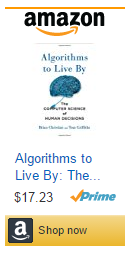 I love logic, so I love algorithms. I continue to enjoy optimizing the algorithms we developed for ContentWRX and Content Science Review, for example. Author Brian Christian and cognitive scientist Tom Griffiths guide us on a tour of a wide range of problems and algorithms, suggesting how both computer decisions and very human decisions have benefited—and can continue to do so. This duo weaves together history, research results, and examples from a variety of disciplines to create a book unlike any I’ve ever read. Not only do I love algorithms, I love this book.
I love logic, so I love algorithms. I continue to enjoy optimizing the algorithms we developed for ContentWRX and Content Science Review, for example. Author Brian Christian and cognitive scientist Tom Griffiths guide us on a tour of a wide range of problems and algorithms, suggesting how both computer decisions and very human decisions have benefited—and can continue to do so. This duo weaves together history, research results, and examples from a variety of disciplines to create a book unlike any I’ve ever read. Not only do I love algorithms, I love this book.
Realistically optimistic. That’s the characteristic about this book I love most. Far from sensational, this book patiently, politely, and positively gives you a new perspective on an eclectic mix of problems and issues such as:
- Why seniors tend to have smaller social networks. Hint: Not the stereotypical reasons you’re thinking.
- Why there is no perfect answer to organizing a closet (or really any digital experience)—but there is an optimal answer.
- Why an algorithm, with little data, from World War II predicted the rate at which the Nazis were producing tanks far better than people with much more data.
And experiencing this new perspective alone will leave you rethinking problems and decisions you face.
One of my content predictions for 2017 is unprecedented focus on content automation to drive dynamic, personalized content delivery, artificial intelligence, and more. What does content automation demand? Algorithms and logic, among other things. So, settle in and get to know an algorithm or two. You’ll be living—and working—by them more this year than ever before. Algorithms are becoming our brains.
10. Smarter Faster Better
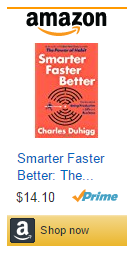 Who doesn’t want to be all of those things? Journalist Charles Duhigg explores research-based principles to make us more productive in life and business. But, before we get to that, let me say this.
Who doesn’t want to be all of those things? Journalist Charles Duhigg explores research-based principles to make us more productive in life and business. But, before we get to that, let me say this.
This book holds the secret that at least partly explains the results in the 2016 U.S. presidential election.
Of course, this book was written before the election, so Duhigg does not make any such claim. So, what am I talking about? In the first chapter Duhigg explains the connection between being motivated and feeling in control or autonomous. Among the examples is a “nursing home rebellion,” where the seniors who were thriving in their twilight years were the ones breaking the rules. They moved furniture. They swapped food. They didn’t accept all of the decisions made for them by the nursing home. They took control, even if in very small ways.
In a similar vein, the media often acted like the nursing home toward American voters, especially older voters and voters without a college education. Many news, commentary, and even entertainment programs and sites—going by a range of polls and research and reaction to the debates—understandably treated Clinton’s win or Trump’s loss as inevitable. As the rule to accept. Could that treatment have triggered a nursing-home-style rebellion, motivating people to break the rule and vote for a different decision, even if an imperfect one? I think so. And I think the connection between motivation and control largely explains what makes the change element in the primary model (the model developed by Helmut Norpoth that correctly predicted Trump’s victory) work.
Enough about politics, let’s get back to productivity. I love every chapter in this book, but perhaps my favorite is Decision Making. If you read Clout, you know that I’m passionate about the way content can influence decisions for the better. I’m also passionate about helping companies make better decisions about content itself. This chapter explores principles from poker to make you—or your machine, in the case of machine learning and artificial intelligence—more likely to place your “bet” on the right decision. One key is having the right data, and I’m enthusiastic that content intelligence will evolve more in 2017 to empower our content teams and content machines with data for better content decisions.
11. Getting Naked
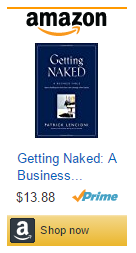 Sometimes, asking “stupid” questions is the best thing a consultant or advisor can do for a client because those questions reveal faulty assumptions, unlock new ideas, or reveal a fresh perspective. That’s only one of the takeaways from this unusual yet highly effective book. Patrick Lencioni diverts from the typical business self-help tomb to offer a fable illustrating the power of building business relationships based on transparency and trust. Yes, data and facts and strategy and technology are important and always will be. But, they’re meaningless without strong relationships and a culture of trust among the people making, executing, and evaluating the decisions.
Sometimes, asking “stupid” questions is the best thing a consultant or advisor can do for a client because those questions reveal faulty assumptions, unlock new ideas, or reveal a fresh perspective. That’s only one of the takeaways from this unusual yet highly effective book. Patrick Lencioni diverts from the typical business self-help tomb to offer a fable illustrating the power of building business relationships based on transparency and trust. Yes, data and facts and strategy and technology are important and always will be. But, they’re meaningless without strong relationships and a culture of trust among the people making, executing, and evaluating the decisions.
On a more practical note, I love how this brings to life important implications, such as RFPs (really flatulent paperwork, as Alan Weiss calls it) and pitches are terrible ways to select a partner or advisor. And do you really want to work with a “vendor” that isn’t a partner or advisor—that isn’t personally committed to mutual success?
So, I hope this list inspires you to read and listen to the wealth of fantastic content in the form of books available to us today. I know the insights you glean will be different and interesting. Don’t hesitate to share with me or in the comments below.
As for 2017, wish me luck with my new goal of …. 25 books.
Events, Resources, + More
The Ultimate Guide to End-to-End Content
Discover why + how an end-to-end approach is critical in the age of AI with this comprehensive white paper.
The Content Advantage Book
The much-anticipated third edition of the highly rated book by Colleen Jones is available at book retailers worldwide. Learn more!
20 Signs of a Content Problem in a High-Stakes Initiative
Use this white paper to diagnose the problem so you can achieve the right solution faster.
Upskill with Content Science Academy
Training for modern content roles through on-demand certifications + courses or live workshops.







Comments
We invite you to share your perspective in a constructive way. To comment, please sign in or register. Our moderating team will review all comments and may edit them for clarity. Our team also may delete comments that are off-topic or disrespectful. All postings become the property of
Content Science Review.